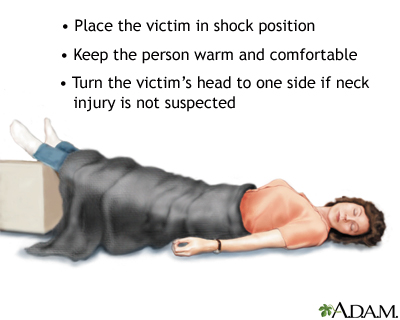Health Library
Shock
Shock is a life-threatening condition that occurs when the body is not getting enough blood flow. Lack of blood flow means the cells and organs do not get enough oxygen and nutrients to function properly. Many organs can be damaged as a result. Shock requires immediate treatment and can get worse very rapidly. As many 1 in 5 people in shock will die from it.
Images

I Would Like to Learn About:
Considerations
The main types of shock include:
- Cardiogenic shock (due to heart problems)
- Hypovolemic shock (caused by too little blood volume)
- Anaphylactic shock (caused by allergic reaction)
- Septic shock (due to infections)
- Neurogenic shock (caused by damage to the nervous system)
Causes
Shock can be caused by any condition that reduces blood flow, including:
- Heart problems (such as heart attack or heart failure)
- Low blood volume (as with heavy bleeding or dehydration)
- Changes in blood vessels (as with infection or severe allergic reactions)
- Certain medicines that significantly reduce heart function or blood pressure
- Slow heart rates and changes in blood vessel tone from spinal injuries
Shock is often associated with heavy external or internal bleeding from a serious injury.
Toxic shock syndrome is an example of shock that is caused by an infection.
Symptoms
A person in shock has extremely low blood pressure. Depending on the specific cause and type of shock, symptoms will include one or more of the following:
- Anxiety or agitation/restlessness
- Bluish lips and fingernails
- Chest pain
- Confusion
- Dizziness, lightheadedness, or faintness
- Pale, cool, clammy skin
- Low or no urine output
- Profuse sweating, moist skin
- Rapid but weak pulse
- Shallow breathing
- Being unconscious (unresponsive)
First Aid
Take the following steps if you think a person is in shock:
- Call 911 or the local emergency number for immediate medical help.
- Check the person's airway, breathing, and circulation. If necessary, begin rescue breathing and CPR.
- Even if the person is able to breathe on their own, continue to check rate of breathing at least every 5 minutes until help arrives.
- If the person is conscious and DOES NOT have an injury to the head, leg, neck, or spine, place the person in the shock position. Lay the person on the back and elevate the legs about 12 inches (30 centimeters). DO NOT elevate the head. If raising the legs will cause pain or potential harm, leave the person lying flat.
- Give appropriate first aid for any wounds, injuries, or illnesses.
- Keep the person warm and comfortable. Loosen tight clothing.
IF THE PERSON VOMITS OR DROOLS
- Turn the person or their head to one side to prevent choking if you do not suspect an injury to the spine.
- If a spinal injury is suspected, "log roll" the person instead. To do this, keep the person's head, neck, and back in line, and roll the body and head as a unit.
Do Not
In case of shock:
- DO NOT give the person anything by mouth, including anything to eat or drink.
- DO NOT move the person with a known or suspected spinal injury.
- DO NOT wait for milder shock symptoms to worsen before calling for emergency medical help.
When to Contact a Medical Professional
Call 911 or the local emergency number any time a person has symptoms of shock. Stay with the person and follow the first aid steps until medical help arrives.
Prevention
Learn ways to prevent heart disease, falls, injuries, dehydration, and other causes of shock. If you have a known allergy (for example, to insect bites or stings), carry an epinephrine pen. Your health care provider will teach you how and when to use it.
Related Information
Cardiogenic shockHypovolemic shock
Anaphylaxis
Septic shock
Low blood pressure
References
Angus DC. Approach to the patient with shock. In: Goldman L, Schafer AI, eds. Goldman-Cecil Medicine. 26th ed. Philadelphia, PA: Elsevier; 2020:chap 98.
Puskarich MA, Jones AE. Shock. In: Walls RM, Hockberger RS, Gausche-Hill M, eds. Rosen's Emergency Medicine: Concepts and Clinical Practice. 9th ed. Philadelphia, PA: Elsevier; 2018:chap 6.
Smith SG, Schreiber MA. Shock, electrolytes, and fluid. In: Townsend CM Jr, Beauchamp RD, Evers BM, Mattox KL, eds. Sabiston Textbook of Surgery. 21st ed. St Louis, MO: Elsevier; 2022:chap 4.
BACK TO TOPReview Date: 11/13/2021
Reviewed By: Jesse Borke, MD, CPE, FAAEM, FACEP, Attending Physician at Kaiser Permanente, Orange County, CA. Also reviewed by David Zieve, MD, MHA, Medical Director, Brenda Conaway, Editorial Director, and the A.D.A.M. Editorial team.
 | A.D.A.M., Inc. is accredited by URAC, for Health Content Provider (www.urac.org). URAC's accreditation program is an independent audit to verify that A.D.A.M. follows rigorous standards of quality and accountability. A.D.A.M. is among the first to achieve this important distinction for online health information and services. Learn more about A.D.A.M.'s editorial policy, editorial process and privacy policy. A.D.A.M. is also a founding member of Hi-Ethics. This site complies with the HONcode standard for trustworthy health information: verify here. |
The information provided herein should not be used during any medical emergency or for the diagnosis or treatment of any medical condition. A licensed medical professional should be consulted for diagnosis and treatment of any and all medical conditions. Links to other sites are provided for information only -- they do not constitute endorsements of those other sites. © 1997- 2022 A.D.A.M., a business unit of Ebix, Inc. Any duplication or distribution of the information contained herein is strictly prohibited.
